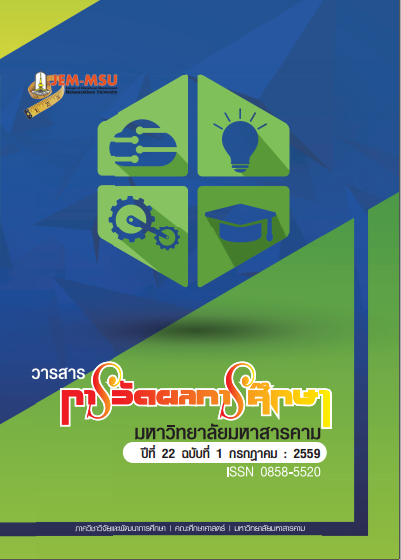The Developing of the Primary School Teacher Competencies Assessment Model in Office of the Basic Education Commission
Main Article Content
Abstract
This research aims to develop the primary school teachers competencies assessment
model in Office of the Basic Education Commission. The research and development process
are divided into four stages: 1) analyze and synthesize, component of competencies assessment
model, competencies, indicators and assessment criteria. By studying the texts, articles,
reports, research papers and databases, the experts were interviewed 5 people and ask 15
people, who stakeholder with teacher 2) create a model to assessment and manual of the
assessment model. By bringing information from Step 1 to be the draft of assessment model.
Check the propriety and feasibility of the model by 9 experts applying the discussions MACR. 3)
Trial assessment model to 10 administrators, 40 colleagues, 40 teachers who evaluated and
200 students and 4) Assessment the model by 100 experiments involved: The instruments
to collect data consisted of questionnaires and statistics used in this study consists of basic
statistics were mean, standard deviation, median and range between quartiles. The hypothesis
was tested with Mann-Whitney U test and The Kruskal-Wallis test. The results were as
follows: 1) The Competencies assessment model, that researchers developed were shows
the structure entailing; objective assessment, assessment content, indicators and criteria,
evaluator, assessment methods, assessment period, and providing feedback. The competencies
include 4 personal competencies; management and self-development, working with others,
adaptability, the ethics and 7 job competencies; curriculum and learning management,
classroom Management, students development, Measurement and evaluation, research,
language and technology, and knowledge cultivate. 2) The model had discriminant validity,
that can separate the teachers. who more features and functions behave differently. 3) The
model had all each aspects at a high level for utility, feasibility, propriety, and accuracy.
Article Details
The content and information contained in the published article in the Journal of Educational Measurement Mahasarakham University represent the opinions and responsibilities of the authors directly. The editorial board of the journal is not necessarily in agreement with or responsible for any of the content.
The articles, data, content, images, etc. that have been published in the Journal of Educational Measurement Mahasarakham University are copyrighted by the journal. If any individual or organization wishes to reproduce or perform any actions involving the entirety or any part of the content, they must obtain written permission from the Journal of Educational Measurement Mahasarakham University.


